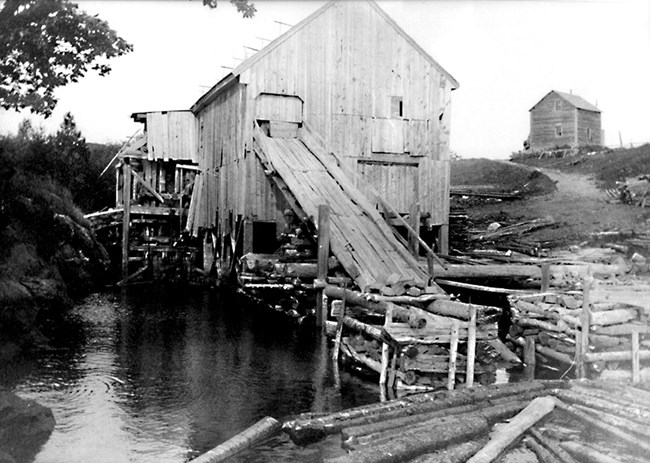Last updated: February 11, 2022
Article
Timbering on Mount Desert Island

From the very earliest days of European settlement on Mount Desert Island (MDI), pioneering families took advantage of rich forest resources to provide them with building materials and as a source of income.
By 1794 the Peters map of MDI shows the island ringed by eleven sawmills along its coast at the mouth of streams emptying into the ocean. Mills operated at the outlet of Northeast Creek, Hulls Cove Brook, Duck Brook, Cromwell Brook, Hadlock Brook, Richardson Brook, Somes Pond outlet, Seal Cove Pond outlet and Otter Creek Cove as well as the interior sawmills at Dennings Brook on Echo Lake and at the Heath on Stony Brook.
Water power provided by the streams ran sawmills that turned out lumber for houses, barns and ship building. Additional goods produced by the mills such as clapboards, staves, spools, laths, shingles, barrels and boxes were used locally or shipped away to markets along the east coast. Edward Brewer, owner of four sawmills, saved the expense of trucking lumber from New Mill Meadow on Duck Brook by building water sluices alongside the Duck Brook to carry the milled lumber to the ocean shore for his ship building business.
By the mid 1800s even more steam-powered sawmills on Long Pond and along the shore in Bar Harbor increased the local lumber industry but eventually lumber coming from Pennsylvania out-competed the commercial shipping of lumber from Mount Desert Island to elsewhere.
Much to the consternation and alarm of conservationists such as George Dorr and Charles Eliot, the invention of the portable sawmill in the early 1900s allowed lumbermen to access the more remote interior areas of the island prompting efforts to preserve the landscape by establishing the Hancock County Trustees for Public Reservations and eventually the founding of Acadia National Park.
Today visitors can see the old stone remnants of sawmill dams near the Duck Brook carriage road bridge and along the Kebo Brook trail. Stone foundations from the Stevens and Cooper sawmill are visible along the shore of Long Pond; the Heath sawmill along the Seal Cove Pond outlet left behind carefully constructed stone work from 1780s as reminders of a once prosperous business.
It may be difficult for today's visitors to imagine the deforestation of Mount Desert Island prior to its preservation. However, thousands of years of occupation by Native Americans who utilized the land-based resources and were later joined by hundreds of years of European settlement, left the trees and forests of MDI far from untouched.
Article by Terese Miller
Sources
Higgins, A. L., Bar Harbor Times, Nov. 21, 1928
Wells, Walter, “The Water Power of Maine”, Hydrographic Survey of Maine, 1869
Hamor, Eben, Bar Harbor Times, Feb. 6, 1915
Spiker, LaRue, Seal Cove Once Knew Life of Economic Activities- Faint Memories Remain, Bar Harbor Times, May 25, 1961
